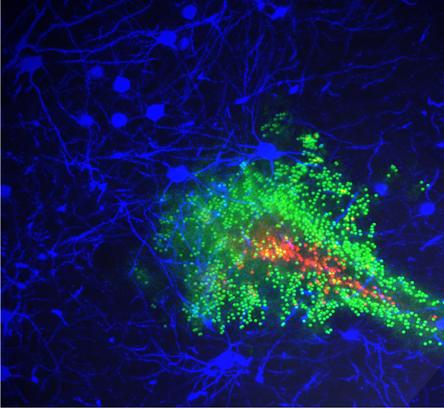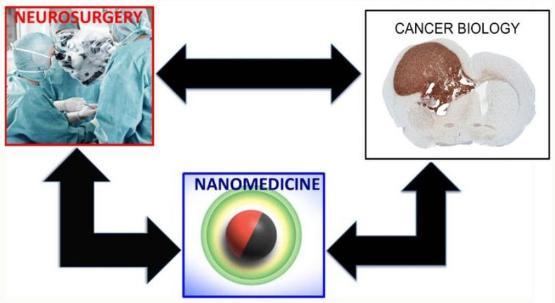Projects
Our Team is Committed to the Development of Novel Therapies to Conquer Devastating Diseases in the Neuroscience and Cancer Fields
1. Cancer Biology (Lead PI: Jeff Winkles, PhD)

The TWEAK/Fn14 signaling dyad. Both membrane-anchored TWEAK and soluble TWEAK monomers assemble into trimers. TWEAK binding to the Fn14 extracellular domain promotes Fn14 trimerization and binding of TRAF adaptor proteins to the Fn14 cytoplasmic tail. This interaction triggers the activation of various downstream protein kinases, only some of which are shown here, and signaling cascades, including the classical (c) and alternative (a) NF-κB pathways, resulting in transcription factor binding to genomic DNA and the expression of numerous TWEAK-inducible genes, including Fn14. TWEAK:Fn14 engagement stimulates various cellular responses such as growth, migration, invasion and differentiation.

Fn14 mRNA levels correlate with glioblastoma (GBM) patient survival and Fn14 protein is highly expressed in primary GBM tumors. (A) Kaplan-Meier survival curves for GBM patients harboring tumors with high or low levels of Fn14 gene expression. Median survival for Fn14-low patients (n= 56) is 40 months while median survival for Fn14-high patients (n=184) is 14 months (p<0.01). (B) Immunohistochemical analysis of Fn14 expression in representative non-neoplastic brain and GBM tumor tissue samples (Fn14-positive cells are stained brown).
Representative Publications:
- Connolly NP, Galisteo R, Xu S, Bar EE, Peng S, Tran NL, Ames HM, Kim AJ, Woodworth GF, Winkles JA. (2021) Elevated fibroblast growth factor-inducible 14 expression transforms proneural-like gliomas into more aggressive and lethal brain cancer. Glia 69, 2199-2214.
- Hersh DS, Harder BG, Roos A, Peng S, Heath JE, Legesse T, Kim AJ, Woodworth GF, Tran NL, Winkles JA. (2018) The TNF receptor family member Fn14 is highly expressed in recurrent glioblastoma (GBM) and in GBM patient-derived xenografts with acquired temozolomide resistance. Neuro-Oncology 20, 1321-1330.
- Hersh DS, Peng S, Dancy JG, Galisteo R, Eschbacher JM, Castellani RJ, Heath JE, Legesse T, Kim AJ, Woodworth GF, Tran NL, Winkles JA. (2018) Differential expression of the TWEAK receptor Fn14 in IDH1 wild-type and mutant gliomas. Journal of Neuro-Oncology 138, 241-250.
- Perez JG, Tran NL, Rosenblum MG, Schneider CS, Connolly NP, Kim AJ, Woodworth GF, Winkles JA. (2016) The TWEAK receptor Fn14 is a potential cell surface portal for targeted delivery of glioblastoma therapeutics. Oncogene 35, 2145-2155.
2. Drug Delivery (Lead PI: Anthony Kim, PhD)

Nanoparticle formulations designed to minimize non-specific binding enable improved penetration and dispersion within tissues. Here, nanoparticles with very dense PEG coatings (green) are shown penetrating within brain tissue in vivo. Uncoated particles (red) with hydrophobic and negative charge surface regions display limited dispersion within brain tissue. Minimizing the non-specific bindings of therapeutic formulations is a foundational principle of our work.

Decreased nonspecific adhesivity, receptor-targeted (DART) therapeutic nanoparticles. Conventional, drug-loaded NPs without a specialized surface coating penetrate poorly through brain extracellular space after local administration (normal brain cells indicated with white circles containing black lines; catheter is indicated using dark black V) and Fn14 targeting is restricted to those tumor cells close to the catheter entry point (white circles; Fn14 molecules indicated with rectangles). In contrast, NPs engineered for enhanced tumor-penetrating capacity move deeper into the adjacent brain parenchyma and surface decoration with an Fn14 targeting moiety may increase NP binding to the invasive glioma cells.
Representative Publications:
- Dancy JG, Wadajkar AS, Connolly NP, Galisteo R, Ames HM, Peng S, Tran NL, Goloubeva OG, Woodworth GF, Winkles JA, Kim AJ. (2020) Decreased nonspecific adhesivity, receptor-targeted therapeutic nanoparticles for primary and metastatic breast cancer. Science Advances 6, eaax3931.
- Wadajkar AS, Dancy JG, Roberts NR, Connolly N, Strickland DK, Winkles JA, Woodworth GF, Kim AJ. (2017) Decreased non-specific adhesivity, receptor targeted (DART) nanoparticles exhibit improved dispersion, cellular uptake, and tumor retention in invasive gliomas. Journal of Controlled Release 267, 144.
- Schneider CS, Perez JG, Cheng E, Zhang C, Panagiotis M, Hanes J, Winkles JA, Woodworth GF, Kim AJ. (2015) Minimizing the non-specific binding of nanoparticles to the brain enables active targeting of Fn14-positive glioblastoma cells. Biomaterials 42, 42.
- Nance EA, Woodworth GF, Sailor KA, Shih TY, Xu Q, Swaminathan G, Xiang D, Eberhart C, Hanes J (2012) A dense poly(ethylene glycol) coating improves penetration of large polymeric nanoparticles within brain tissue. Science Translational Medicine 4, 149ra119.
3. Translational Research (Lead PI: Graeme Woodworth, MD)

MRgFUS BBBD in tumor-bearing rodents, canines, and humans. T1-weighted post contrast images before and after MRgFUS in non-enhancing brain tumor regions, respectively: (a, b) human, (c,d) mouse, (e,f) rat, and (g,h) canine.

Schematic depiction of the RCAS-Ntv-a rat glioma model. (A) Transgenic Sprague-Dawley rats were created using site-specific transposase technology with the tv-a gene under control of the nestin promoter. (B) Chicken fibroblast DF1 cells are transfected with RCAS constructs (e.g. PDGFA and p53 shRNA) that propagate and release RCAS virions into the culture media (C) DF1 cells are injected into the transgenic rats and the RCAS virions bind to the tv-a receptor expressed on neural precursor cells in which the nestin gene promoter is active. Once inside the cell, the DNA insert is integrated to produce stable gene expression changes leading to tumor formation. RCAS virions do not enter differentiated brain cells where the nestin promoter is inactive.
Representative Publications:
- Anastasiadis P, Ghandi D, Guo Y, Ahmed A-K, Bentzen SM, Arvantis C, Woodworth GF. (2021) Localized blood-brain barrier opening in infiltrating gliomas with MRI-guided acoustic emissions-controlled focused ultrasound. Proceedings of the National Academy of Sciences 118, e2103280118.
- Hersh D, Anastasiadis P, Mohammadabadi A, Nguyen BA, Guo S, Winkles JA, Kim AJ, Gullapalli RP, Keller A, Frenkel V, Woodworth GF. (2018) MR-guided transcranial focused ultrasound safely enhances interstitial dispersion of large polymeric nanoparticles in the living brain. PLoS ONE 13, e0192240.
- Connolly N, Shetty A, Stokum J, Hoeschele I, Siegel M, Miller CR, Kim AJ, Ho C, Davila E, Simard JM, Devine S, Rossmeisl J, Holland E, Winkles J, Woodworth GF. (2018) Cross-species transcriptional analysis reveals conserved and host-specific neoplastic processes in mammalian glioma. Scientific Reports 8, 1180.
- Connolly N, Stokum JA, Schneider CS, Ozawa T, Xu S, Galisteo R, Castellani RJ, Kim AJ, Simard JM, Winkles JA, Holland EC, Woodworth GF. (2017) Genetically engineered rat gliomas: PDGF-driven tumor initiation and progression in tv-a transgenic rats recreate key features of human brain cancer. PLoS ONE 12, e0174557.

